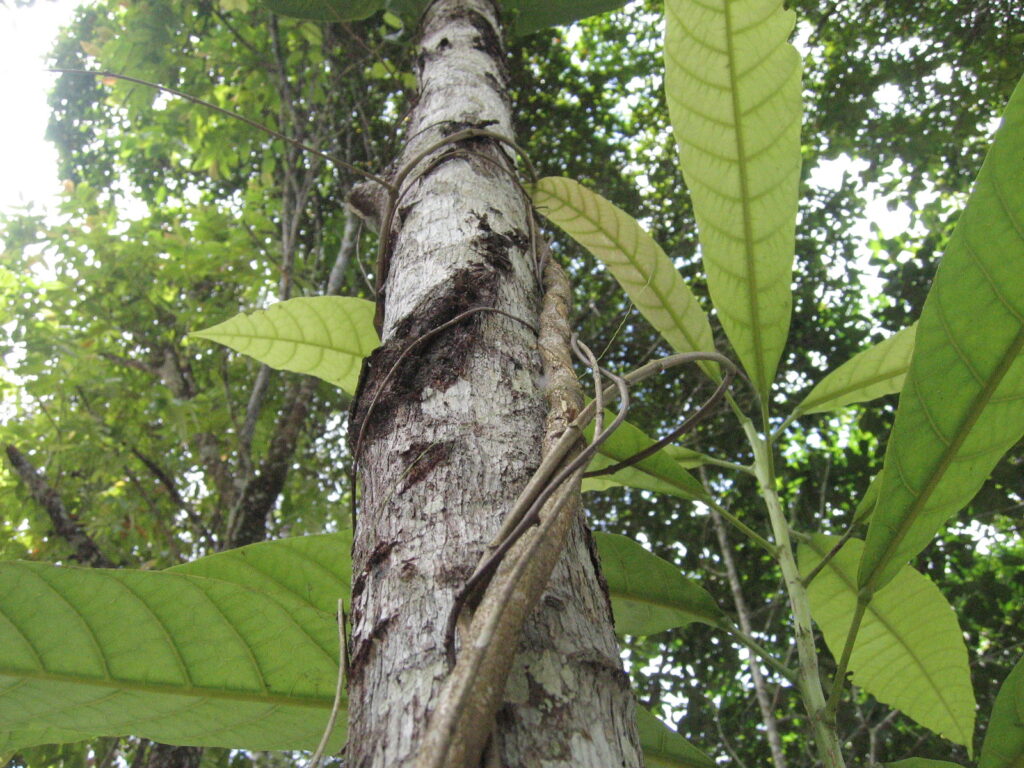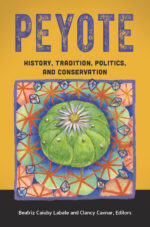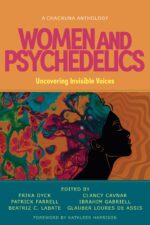- Yaminawa Women and Ayahuasca: Shamanism, Gender, and History in the Peruvian Amazon - February 2, 2022
- Ayahuasca Makes you See, and Tobacco Makes You Dream - September 14, 2020

One afternoon in November 2003, a surprising event took place in the Yaminawa village of Raya, situated along the Mapuya River in the Peruvian Amazon, where I was conducting research. Suddenly, two young girls were victims of a kind of attack that no one could explain. They screamed in pain, writhing and rolling on the ground. Their stomachs ached, and their displays of suffering left everyone perplexed, but no detailed explanations were forthcoming. Some tablets, as well as compresses and infusions, prepared with herbs that the Yaminawa women cultivate in their yards, were the first attempts at treatment. However, in the face of the obvious lack of effect and the worsening of the screams, the mother of one of the girls began to smoke tobacco and blew the fumes onto her daughter’s belly, and then she chewed chili pepper and sucked the sore part of the girl’s body.
The woman, Txixëya, repeated this operation several times: after sucking hard, she spat out some mucus. After performing the procedure three or four times, she examined the accumulation of mucus and found that she had drawn blood. She poured water over the saliva, which dissolved and dripped between the cracks in the floor made of pona wood, and continued to smoke, chew chili, and suck on her daughter’s belly. When she saw that there were no more traces of blood in the saliva, she terminated the operation. Her daughter Patxuawĩ had by then calmed down.
In addition to these spectacular attacks, one thing caught my attention: the fact it was a woman who performed the operation to draw blood by sucking, which until then I had not witnessed. In all previous accounts I had collected this ability was attributed to people who were recognized as having shamanic power. This technique, bëa kuui, is associated with the treatment of localized pain, swelling, and, especially, the bites of poisonous striped snakes.
“I ARGUE HERE THAT THERE IS A CONNECTION BETWEEN THIS APPARENT SEPARATION OF THE SHAMANIC AND FEMALE UNIVERSES, AND THE TRANSFORMATIONS CAUSED BY THE ESTABLISHMENT OF CONTINUOUS RELATIONSHIPS WITH NON-INDIGENOUS PEOPLE.”
The relationship between Yaminawa women and shamanism is far from obvious. It is a primarily male universe though it is not exclusive to men. The most visible and well-known shamanic practice today among the Indigenous Pano peoples, including the Yaminawa, is that which revolves around ayahuasca. Despite this, when I spoke with my female interlocutors about it and asked them if they had ever taken ayahuasca, the most frequent answer was that they had not tried it because they were afraid. For a time, this recurring response made me think that women were simply excluded from shamanic practice, as is the case among other peoples; however, this is a misconception. I argue here that there is a connection between this apparent separation of the shamanic and female universes, and the transformations caused by the establishment of continuous relationships with non-Indigenous people. In this sense, the lack of ayahuasca consumption by Yaminawa women today has to be understood as the result of a certain regional historical process, and, furthermore, this does not imply their exclusion from shamanic practices.
The Yaminawa are an Indigenous people who speak a Pano language who, upon the arrival of colonization in the second half of the nineteenth century, occupied the region of confluence of headwaters formed by the basins of the Purús, Tarauacá, Envira, and Yuruá rivers. This is currently a border region between the Brazilian state of Acre, the Peruvian state of Ucayali, and the state of Pando in Bolivia. With the arrival of the rubber and seringa extraction fronts, the ancestors of the Yaminawa, like other culturally close neighbors, were captured for their labor, or they spread out to even more inaccessible areas, fleeing violence, slavery, and epidemics. Many Pano peoples established lasting relationships with national societies throughout the second half of the twentieth century though there are still today groups that resist this and remain in voluntary isolation.

Discover the Indigenous Reciprocity Initiative of the Americas
Several of these peoples share a very close language, as well as similar ways of life, ways of being, and social and cosmopolitical logic. Among the most characteristic and similar aspects are the shamanic practices and cosmologies, in which ayahuasca is one of the main elements. Most of the adult Yaminawa men over 30 years old in the 2000s had, during their youths, undergone a shamanic learning process that combines nutritional and sexual diets, social isolation, intensive consumption of various substances (especially tobacco, ayahuasca, and chili peppers), the kuxuiti (curing) songs sung during ayahuasca sessions,1 and submission to ordeals that involve being stung by certain types of ants and wasps and ingesting organic substances from the boa constrictor.
Through these actions, two closely connected and parallel processes operate. On the one hand, there is a self-management of bodily substances, through the accumulation of certain substances—those which are bitter (bua) and/or those that give power (paë) to the voice and visions—and the avoidance or expulsion of others, mainly, those classified as “sweet” (bata), such as the fermented yucca drink or any non-Indigenous food. Through vomiting, the remains of meat and “dirt” accumulated in the stomach and which interfere with the shamanic agency are also expelled. The shamanic body is light and bitter. After the somatic cleansing, ayahuasca is ingested—the second process I was referring to—and thus comes into contact with the yuxin (spirits) and ihu (owners) associated with those substances, such as those from the boa or ayahuasca, which are converted into transmitters of knowledge mainly in the form of chants. Thus, if the learning and development of shamanic agency is associated with contact with the yuxin and ihu, the ultimate sources of this agency, they depend on the preparation of the human body itself and the manipulation of the substances that form it.
Although my female interlocutors claimed not to have taken ayahuasca, they assured me that many of their mothers and grandmothers had. This means that, in the generation of those who were adults when stable relationships were established with broader Peruvian society in the 1960s, it was common for women to consume ayahuasca.2 According to various accounts, the women took part both in collective ayahuasca ingestion sessions that had no aim other than to interact with the yuxin, and in healing rituals, where some women contributed with their kuxuiti (song) to restore a patient’s health.

But what was the real dimension of women’s participation in the shamanic universe? When, on the day after the healing incident described above, I spoke with Txixëya again, she explained to me that she had learned to suck “blood” using chili pepper and tobacco from her father and her mother. Both were kuxuitia, a category which refers to those who know the curing songs, typically chanted when taking ayahuasca. Txixëya’s mother was taught by her own father when she was young. To do this, he made her diet; get stung by wasps in the mouth and on her chest; take honey to vomit and connect with its “owner”; smoke the pipe which her father had previously smoked; and, certainly, regularly consume shamanic substances such as ayahuasca, tobacco, or chili. The learning and development of shamanic agency operates by the same processes in the case of men and women, but in the case of men it was formerly carried out collectively—several boys undertook the initiation together usually under the direction of two teachers—and with women the initiation took place on an individual basis within the family environment. It was the fathers, mothers, and husbands who encouraged the girls to learn modes of action considered essential to ensure their personal well-being since consuming ayahuasca “fixes” and keeps the body healthy, and also the well-being of the family as it gave them autonomy to take care of their loved ones.
Thus, the ingestion of ayahuasca were part of a much broader framework of practices which included other substances and other techniques, apart from kuxuiti. The exercise of shamanism, on the other hand, was not exclusive to specialists, but, with different degrees of effectiveness, was relatively generalized. Certainly, not everyone was given the same credibility, but access to these practices was democratic and basically depended on having among those closest someone willing to teach and on others being determined to face the rigor of learning. Some of my female interlocutors assured me that if they did not learn, it was not due to lack of opportunity but rather because they did not want to face the diets and the painful bites of the insects.
“WHY, WHEN THEY LIVED APART FROM PERUVIAN SOCIETY, DID WOMEN PARTICIPATE MORE ACTIVELY IN SHAMANISM, INCLUDING THE REGULAR CONSUMPTION OF AYAHUASCA…?”
The question that must be asked, then, is why, when they lived apart from Peruvian society, did women participate more actively in shamanism, including the regular consumption of ayahuasca, and when permanent relationships with society were established, why did this consumption decrease?
Shamanism, as a cosmopolitics that is effective through concrete actions, is in constant transformation, and the Yaminawa are always open to incorporating new ideas and techniques. In fact, everything seems to indicate that the use of ayahuasca in this case is relatively recent and differs from previous forms of shamanism, in which tobacco, the jaguar, and hunting, and not ayahuasca, the boa, and the cure, were the main ingredients.3 This seems to be in line with Peter Gow’s hypothesis published in Shamanism, History, and the State (1996) that the current ayahuasca shamanism was configured in the missions during the colonial era and then expanded towards the headwaters of the rivers, even reaching peoples who had not yet established permanent contact.
The consumption of ayahuasca by Yaminawa women before contact is no exception in the Pano world. Barbara Keifenheim reported a similar situation among the Huni Kuin people, explaining that the fact that women do not currently consume ayahuasca is not due to any prohibition but rather to the sedentarization and transformation of their relationship with the jungle. This consideration converges with observations by other authors, such as Philippe Erikson, who worked with recently contacted peoples and indicates that, before contact and due to a way of life marked by great mobility in the jungle, the border between female and male activities was fluid and blurry. After contact, however, as a consequence of sedentarization and the influence of non-Indigenous ideas, there was a tendency to widen gender differences as noted by Carlos Fausto.
Join us for our next conference!
The evidence that women, prior to contact, exercised shamanic practices and consumed ayahuasca is confirmed in the case of recently contacted groups who are culturally very close to the Yaminawa. In 1995, those known as Txitonawa established stable relationships with Peruvian society. As they had settled in the Yaminawa villages of the Mapuya and Yuruá, I had the opportunity to meet a woman who confirmed to me that she and other relatives of hers had drunk ayahuasca from a very young age and knew kuxuiti.
The current decline in the use of ayahuasca among the Yaminawa is not something that affects only women since many men have stopped using it regularly, and it has become a much more sporadic practice than it used to be. However, the truth is that in the case of women there are particular reasons. If it is true, as I mentioned, that a hybrid and mestizo modality focused on the mainly therapeutic use of ayahuasca spread from the missions, the truth is that this modality, when incorporated by various Indigenous and non-Indigenous peoples, took on local characteristics such as female participation. Contemporary Ucayali shamanism, however, has the male ayahuasca healer as its central figure, and as Glenn Shepard has argued this, together with increasing relations with Peruvian society, helps to distance women from this universe.
Nevertheless, the contemporary shamanic universe of the Peruvian Amazon, highly changeable and in which exchanges between different traditions have multiplied exponentially, opens up new possibilities. As for the Yaminawa, a more intense and frequent interaction with the shamanic ways of the jungle town of Atalaya has led them to appropriate and exercise different shamanic techniques, among which stand out those based on the use of plants or the steamings of the Ashaninka tradition, in order to extract disease from the body. Although the use of ayahuasca is not part of the range of healing techniques that they offer their clients, some of these women, like Txixëya, are successfully entering an urban shamanic field from which, paradoxically, Yaminawa men seem to exclude themselves.
This piece was translated from its original Portuguese by John Milton
Art by Karina Alvarez.
Notes
1 For detailed descriptions and analyses of these songs among the Yaminawa and Sharanahua, see Townsley (1993) and Déléage (2009). The kuxuiti songs are different from the songs of ayahuasca (also rabi, like the substance itself) and are not directed to the cure. In any case, it is not conceivable to drink ayahuasca without singing.
2 Faced with the violence of the first contacts, the ancestors of the current Yaminawa retreated to regions of difficult access. This situation of “voluntary isolation” ended in the early 1960s when some young people decided to find ways of having a regular supply of metal tools (Pérez Gil, 2011).
3 See Pérez Gil (2006). For a similar analysis of other Pano groups in the region, see Shepard (2014) and Brabec de Mori (2015).
Take a minute to browse our stock:
Did you enjoy reading this article?
Please support Chacruna's work by donating to us. We are an independent organization and we offer free education and advocacy for psychedelic plant medicines. We are a team of dedicated volunteers!
Can you help Chacruna advance cultural understanding around these substances?















